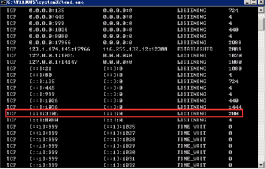安装路径:/application/mysql-5.5.56
1.前期准备
mysql依赖
|
1
|
|
2
|
libaioyum install -y libaio |
创建用户mysql,以该用户的身份执行mysql
|
1
|
|
|
useradd -s /bin/false -M mysql |
下载mysql二进制包并解压
|
1
|
|
2
3
|
cd /toolswget https://dev.mysql.com/get/Downloads/MySQL-5.5/mysql-5.5.56-linux-glibc2.5-x86_64.tar.gztar -zxf mysql-5.5.56-linux-glibc2.5-x86_64.tar.gz -C /application/ |
切换到/application目录,将mysql文件夹名改短,给mysql目录做一个软链接
|
1
|
|
2
3
|
cd /application/mv mysql-5.5.56-linux-glibc2.5-x86_64/ mysql-5.5.56ln -s mysql-5.5.56/ mysql |
递归设置mysql目录的所属组和所属用户
|
1
|
|
|
chown -R mysql:mysql mysql-5.5.56/ |
2.mysql目录内操作
|
1
|
|
|
cd mysql |
初始化数据库
会在mysql目录内生成一个data目录,存放数据库的目录
|
1
|
|
|
./scripts/mysql_install_db --basedir=/application/mysql --datadir=/application/mysql/data/ --user=mysql |
更改所属用户和组
|
1
|
|
2
|
chown -R root .chown -R mysql data |
除了mysql目录下的data目录所属用户不变,其他所有文件的所属用户改为root
拷贝配置文件
|
1
|
|
|
cp support-files/my-medium.cnf /etc/my.cnf |
将mysql的配置文件拷贝为/etc/目录下的my.cnf
修改配置文件
|
1
|
|
|
sed -i 28i'log-error=/application/mysql/data/mysqld.error' /etc/my.cnf |
在配置文件插入了一行,进行配置错误日志
|
1
|
|
2
3
4
5
6
7
8
9
10
11
12
13
14
15
16
17
18
19
20
21
22
23
24
25
26
27
28
29
30
31
32
33
34
35
36
37
38
39
40
41
42
43
44
45
46
47
48
49
50
51
52
53
54
55
56
57
58
59
60
61
62
63
64
65
66
67
68
69
70
71
72
73
74
75
76
77
78
79
80
81
82
83
84
85
86
87
88
89
90
91
92
93
94
95
96
97
98
99
100
101
102
103
104
105
106
107
108
109
110
111
112
113
114
115
116
117
118
119
120
121
122
123
124
125
126
127
128
129
130
131
132
133
|
/etc/my.cnf Content:# Example MySQL config file for medium systems.## This is for a system with little memory (32M - 64M) where MySQL plays# an important part, or systems up to 128M where MySQL is used together with# other programs (such as a web server)## MySQL programs look for option files in a set of# locations which depend on the deployment platform.# You can copy this option file to one of those# locations. For information about these locations, see:# http://dev.mysql.com/doc/mysql/en/option-files.html## In this file, you can use all long options that a program supports.# If you want to know which options a program supports, run the program# with the "--help" option.# The following options will be passed to all MySQL clients[client]#password = your_passwordport = 3306socket = /tmp/mysql.sock# Here follows entries for some specific programs# The MySQL server[mysqld]port = 3306log-error=/application/mysql/data/mysqld.errorsocket = /tmp/mysql.sockskip-external-lockingkey_buffer_size = 16Mmax_allowed_packet = 1Mtable_open_cache = 64sort_buffer_size = 512Knet_buffer_length = 8Kread_buffer_size = 256Kread_rnd_buffer_size = 512Kmyisam_sort_buffer_size = 8M# Don't listen on a TCP/IP port at all. This can be a security enhancement,# if all processes that need to connect to mysqld run on the same host.# All interaction with mysqld must be made via Unix sockets or named pipes.# Note that using this option without enabling named pipes on Windows# (via the "enable-named-pipe" option) will render mysqld useless!##skip-networking# Replication Master Server (default)# binary logging is required for replicationlog-bin=mysql-bin# binary logging format - mixed recommendedbinlog_format=mixed# required unique id between 1 and 2^32 - 1# defaults to 1 if master-host is not set# but will not function as a master if omittedserver-id = 1# Replication Slave (comment out master section to use this)## To configure this host as a replication slave, you can choose between# two methods :## 1) Use the CHANGE MASTER TO command (fully described in our manual) -# the syntax is:## CHANGE MASTER TO MASTER_HOST=, MASTER_PORT=,# MASTER_USER=, MASTER_PASSWORD= ;## where you replace , , by quoted strings and# by the master's port number (3306 by default).## Example:## CHANGE MASTER TO MASTER_HOST='125.564.12.1', MASTER_PORT=3306,# MASTER_USER='joe', MASTER_PASSWORD='secret';## OR## 2) Set the variables below. However, in case you choose this method, then# start replication for the first time (even unsuccessfully, for example# if you mistyped the password in master-password and the slave fails to# connect), the slave will create a master.info file, and any later# change in this file to the variables' values below will be ignored and# overridden by the content of the master.info file, unless you shutdown# the slave server, delete master.info and restart the slaver server.# For that reason, you may want to leave the lines below untouched# (commented) and instead use CHANGE MASTER TO (see above)## required unique id between 2 and 2^32 - 1# (and different from the master)# defaults to 2 if master-host is set# but will not function as a slave if omitted#server-id = 2## The replication master for this slave - required#master-host =## The username the slave will use for authentication when connecting# to the master - required#master-user =## The password the slave will authenticate with when connecting to# the master - required#master-password =## The port the master is listening on.# optional - defaults to 3306#master-port =## binary logging - not required for slaves, but recommended#log-bin=mysql-bin# Uncomment the following if you are using InnoDB tables#innodb_data_home_dir = /usr/local/mysql/data#innodb_data_file_path = ibdata1:10M:autoextend#innodb_log_group_home_dir = /usr/local/mysql/data# You can set .._buffer_pool_size up to 50 - 80 %# of RAM but beware of setting memory usage too high#innodb_buffer_pool_size = 16M#innodb_additional_mem_pool_size = 2M# Set .._log_file_size to 25 % of buffer pool size#innodb_log_file_size = 5M#innodb_log_buffer_size = 8M#innodb_flush_log_at_trx_commit = 1#innodb_lock_wait_timeout = 50[mysqldump]quickmax_allowed_packet = 16M[mysql]no-auto-rehash# Remove the next comment character if you are not familiar with SQL#safe-updates[myisamchk]key_buffer_size = 20Msort_buffer_size = 20Mread_buffer = 2Mwrite_buffer = 2M[mysqlhotcopy]interactive-timeout |
拷贝启动程序
|
1
|
|
|
cp support-files/mysql.server /etc/init.d/mysql |
将mysql的启动程序拷贝到/etc/init.d/目录下,以便启动程序
编辑启动文件,配置启动目录
方法一:
思路是给配置文件提供的变量进行赋值。较麻烦。
|
1
|
|
2
|
sed -i ':a;N;$!ba;s/basedir=\ndatadir=/basedir=\/application\/mysql\ndatadir=\/application\/mysql\/data/g' /etc/init.d/mysqlsed -i ':a;N;$!ba;s/mysqld_pid_file_path=\n/mysqld_pid_file_path=\/application\/mysql\/data\/mysqld.pid\n/g' /etc/init.d/mysql |
等价于将45、46两行
|
1
|
|
2
3
|
basedir=datadir=mysqld_pid_file_path= |
替换成
|
1
|
|
2
3
|
basedir=/application/mysqldatadir=/application/mysql/datamysqld_pid_file_path=/application/mysql/data/mysql.pid |
方法二(推荐):
思路是将脚本的默认地址(/usr/local/mysql)直接替换成自定义路径(/application/mysql),便不用给变量赋值
|
1
|
|
|
sed -i 's#/usr/local/mysql#/application/mysql#g' /etc/init.d/mysql |
到这里mysql安装完成可以正常启动
3.后期结尾
命令创建软链接
将mysql命令创建软链接到环境变量的目录,使用户可以在变量找到相应的命令
|
1
|
|
|
ln -s /application/mysql/bin/* /usr/local/sbin |
设置与修改密码
第一次设置密码:
|
1
|
|
|
mysqladmin -u'' password '' |
例子:
|
1
|
|
|
mysqladmin -u'root' password 'PassWord' |
往后修改密码:
|
1
|
|
|
mysqladmin -u'' -p'' password '' |
例子:
|
1
|
|
|
mysqladmin -u'root' -p'PassWord' password 'NewPassWord' |
登录mysql
|
1
|
|
2
3
4
5
6
7
8
9
10
11
12
|
$ mysql -u'root' -p'PassWord'Welcome to the MySQL monitor. Commands end with ; or \g....mysql> #成功登陆到mysql控制台$ mysql -uroot -pPassWordWelcome to the MySQL monitor. Commands end with ; or \g....mysql> #成功登陆到mysql控制台$ mysql -u'root' -pEnter password: #这里输入用户的密码Welcome to the MySQL monitor. Commands end with ; or \g.... |
mysql> #成功登陆到mysql控制台
|
1
|
|
2
3
4
|
$ mysql -uroot -pEnter password: #这里输入用户的密码Welcome to the MySQL monitor. Commands end with ; or \g.... |
mysql> #成功登陆到mysql控制台
键入quit或Ctrl + d退出mysql环境
|
1
|
|
2
3
4
5
6
|
mysql> quitBye[root@www mysql]#ormysql> ^DBye[root@www mysql]# |
4.常用命令
进入mysql
|
1
|
|
2
3
4
|
mysql -u'root' -p'PassWord'mysql -uroot -pPassWordmysql -u'root' -pmysql -uroot -p |
启动mysql
|
1
|
|
|
service mysql start |
停止mysql
|
1
|
|
|
service mysql stop |
重启mysql
|
1
|
|
|
service mysql restart |
以上所述是小编给大家介绍的Mysql 5.5.56版本(二进制包安装)自定义安装路径步骤记录,希望对大家有所帮助,如果大家有任何疑问请给我留言,小编会及时回复大家的。在此也非常感谢大家对服务器之家网站的支持!
原文链接:http://www.2cto.com/database/201707/654708.html














